
Caribou conservation
Wapusk National Park
Caribou are an essential part of the northern Manitoba ecosystem and vital to northern communities. Valued as part of Indigenous culture, the caribou remains connected to Indigenous values and serve as a way to sustain life. Caribou provide food, clothing, tools and more. However, across much of Canada, caribou populations are in decline. Wapusk National Park, along with regional community members, are currently co-developing strategies on how to sustain healthy caribou herds in the region.
Manitoban Herds
Caribou found in Wapusk belong to one of two designatable units (DU), or populations: the barren-ground (DU 3) and eastern migratory (DU 4) populations. Within the eastern migratory population, the Cape Churchill herd is the most common type of caribou found in Wapusk National Park. From the barren-ground population, the Qamanirjuaq herd migrates into Northern Manitoba and occasionally can be found as far south as the park.
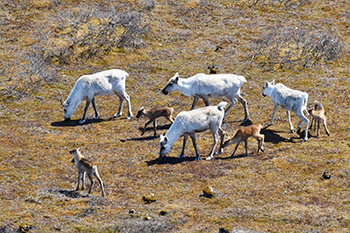
Cape Churchill Herd
Data for the Cape Churchill herd suggests that here has consistently been a fluctuation between 1,000 to 3,000 animals over the past 25 years. The Cape Churchill herd is a unique forest-tundra ecotype with a large portion of their range contained within Wapusk National Park. The herd spends winters in the southwestern portion of Wapusk National Park's boreal forest to shelter from the harsh subarctic winter climate. In the summer months, they migrate nearly 200 kilometres to their calving grounds on the tundra, found near the northern shores of the park at Cape Churchill.
Qamanirjuaq Herd
The Qamanirjuaq herd is a larger herd with an estimated population of 288,000 caribou in 2017. Despite seeming to have a healthy population, the herd has been on a steady and significant decline for more than three decades as population estimates suggested almost 500,000 animals in 1994. Covering a large territory, this herd resides in portions of Manitoba, Nunavut, Saskatchewan and the Northwest Territories. The herd calves in the vicinity of Qamanirjuaq Lake in Nunavut.
Threats to Caribou
Climate change
Although caribou are resilient and have adapted to living in harsh climates, they are not exempt from issues caused by climate change. Changes in climate are regularly mentioned as key threats to the future of caribou. Some changes have already occurred, such as earlier snowmelt, later onset of winter and warmer temperatures. In the coming decades, climate change will continue to pose as a threat to caribou populations in a variety of ways. For example, rising temperatures are likely to increase the period of insect harassment. When caribou are bothered by insects, they tend to form larger groups, and/or try to escape harassment by moving to windy locations that can offer refuge. This behaviour has a negative impact as caribou spend more energy trying to avoid insect harassment rather than feeding.
Also, climate change is likely to lead to an increase in wildfires. Wildfires can cause significant harm to the herd by eliminating tree cover in the overwintering grounds and by eliminating the main caribou food source on the tundra: Lichens. Some studies suggest that lichens do not recover from wildfires for close to 75 years.
Harvesting
Harvesting of caribou is vital to sustaining northern communities and Indigenous culture. There are challenges, though, including ensuring that sustainable harvesting occurs and that hunters follow proper practices. The exact impact of harvesting is unknown; however, it is clear from both scientific and Indigenous Knowledge sources that reducing harvesting pressure plays a part in helping herds recover.
Predators
Wolves are the main predator of caribou across Canada. Polar bears, grizzly bears, black bears, lynx and wolverines in Wapusk are also known to kill caribou or scavenge caribou killed by other factors.

Habitat Loss
Habitat loss has been argued as one of the main drivers behind declines in caribou populations. Disruptions to caribou habitat from human activities such as mining, logging, oil and gas development, power lines, human settlements, cabins, roads and trails can greatly impact caribou. Some studies suggest that caribou will avoid these different types of disturbances on the landscape for up to 23 km. Human structures and features on the landscape can disrupt migration routes, increase movement rates or delay crossing of linear anthropogenic features such as roads, trails and power lines, potentially increasing energy expenditure or reducing the time caribou spend in suitable habitat. Caribou are particularly sensitive to human disturbances resulting in habitat loss on the landscape and their cumulative effects are thought to have contributed to the general decline of caribou across Canada.
Conservation efforts
Habitat protection
Wapusk National Park protects an area from commercial development and limits human disruption. Through the protection of over 11,475 square kilometres, the park assists in the protection of the Cape Churchill Caribou herd’s calving grounds, migration routes and portions of their overwintering habitat. Also, Wapusk National Park supports the establishment of additional protected areas in Northern Manitoba such as the Indigenous Protected and Conserved Area proposals through the Nature Legacy and Canada Nature Funds. Together with Canadians, we are conserving a quarter of our lands and a quarter of our oceans by 2025.
Research and Monitoring
Parks Canada continues to conduct a variety of monitoring efforts to learn more about caribou in Wapusk National Park. Through partnering with community members, Indigenous communities and researchers, a large trail camera project is underway to monitor both locally and regionally. Additionally, working with our partners helps facilitate research efforts in the park including aerial surveys, identifying calving grounds and vegetation surveys. Research and monitoring efforts continues to get collected through various land-based research methods leading to a number of recommended management activities. This data also helps researchers better understand the dynamics of caribou populations that inhabit Wapusk National Park.
Other monitoring efforts include installing trail cameras to help map caribou and general wildlife distribution. This project is a collaboration between Parks Canada, the University of Saskatchewan and the Manitoba Métis Federation. In 2021, a team comprised of representatives from the three organizations headed into the park together to successfully deploy a total of 92 trail cameras in various distinct habitats throughout the park.
Caribou Workshop
About the workshops
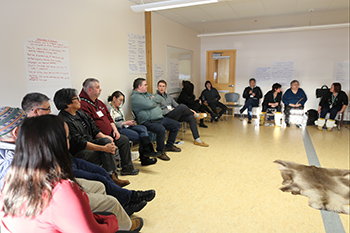
Effective caribou conservation requires cooperation and coordination from various partners and communities. Parks Canada has organized a series of workshops to bring together Indigenous partners (Cree, Dene, Inuit and Métis), government stakeholders (Environment and Climate Change Canada, Parks Canada, provincial and territorial representatives), academic researchers and local community members to share Indigenous and Local Knowledge and western science perspectives surrounding caribou in Wapusk National Park and the Greater Wapusk Ecosystem. The first workshop was held face-to-face in February 2020, and the second virtually in February 2021.
The goal of the workshops is to strengthen and form new relationships, highlight areas of concern, identify knowledge gaps and outline priority actions for effective caribou monitoring and management.
Indigenous voices and knowledge systems were woven throughout the workshop and brought forward a set of diverse themes that helped identify conservation priorities. Participants identified opportunities to support biological and culturally appropriate methods of conservation as well as ways to advance reconciliation through conservation efforts. Wapusk National Park is looking forward to continuing to develop this framework with its partners. Parks Canada is committed to collaborative planning at the landscape scale, respecting Indigenous rights and knowledge systems and creating opportunities for Indigenous stewardship.
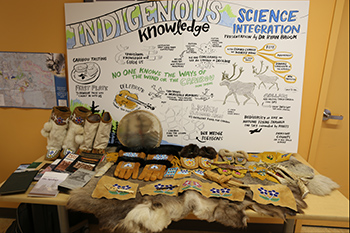
Workshop attendees
Representatives from the following communities and organizations have attended past workshops:
- Canadian Parks and Wilderness Society - Manitoba Chapter
- Environment and Climate Change Canada
- Fox Lake First Nation
- Government of Manitoba
- Government of Nunavut
- Kivalliq Inuit Association
- Manitoba Métis Federation
- Northlands Denesuline First Nation
- Nunavut Tunngavik Incorporated
- Parks Canada
- Sayisi Dene First Nation
- The Beverly Qamanirjuaq Caribou Management Board
- Town of Churchill
- University of Saskatchewan
- York Factory First Nation
- Government of Manitoba
Workshop outcomes
The workshop focused on discussing collaborative solutions and actions to ensure the protection of the Cape Churchill and Qamanirjuaq caribou herds. During the most recent workshop in 2021, five key themes emerged through discussions as critical to ensure effective caribou conservation:
- engaging and educating youth;
- meaningful government engagement;
- raising cultural awareness of Indigenous-led efforts;
- protecting caribou habitat;
- co-monitoring and co-management.
2020 infographic slides
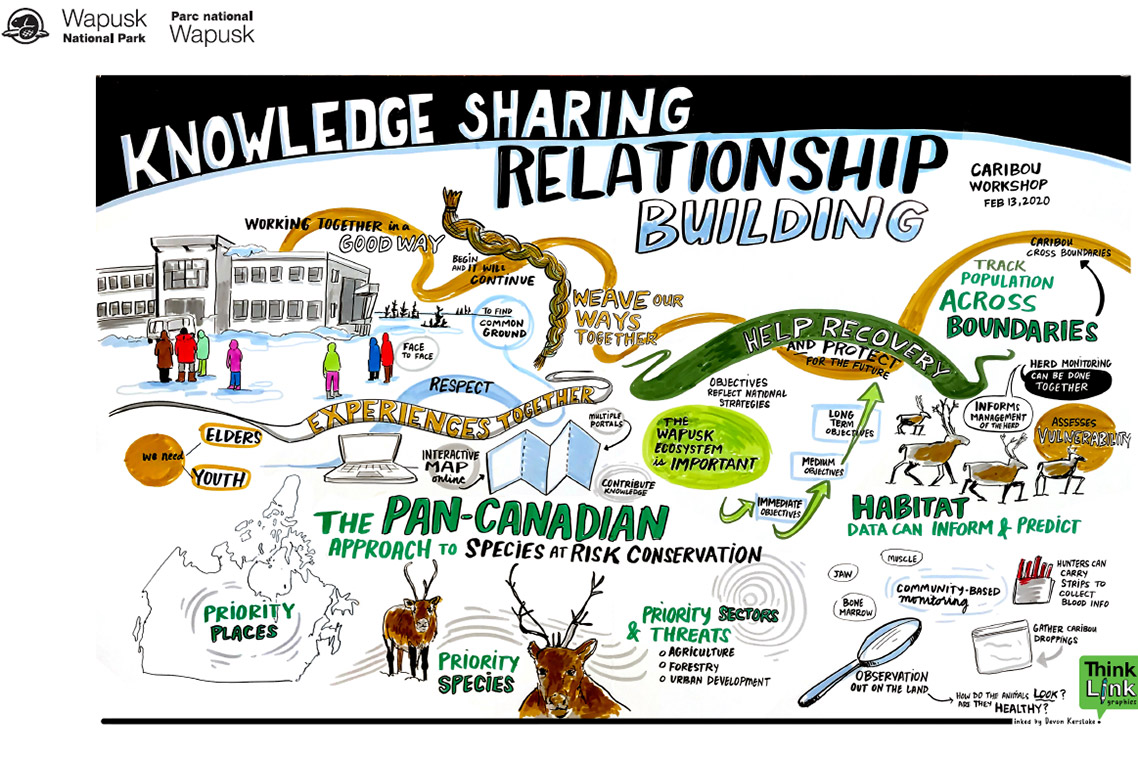
Image description

Image description

Image description
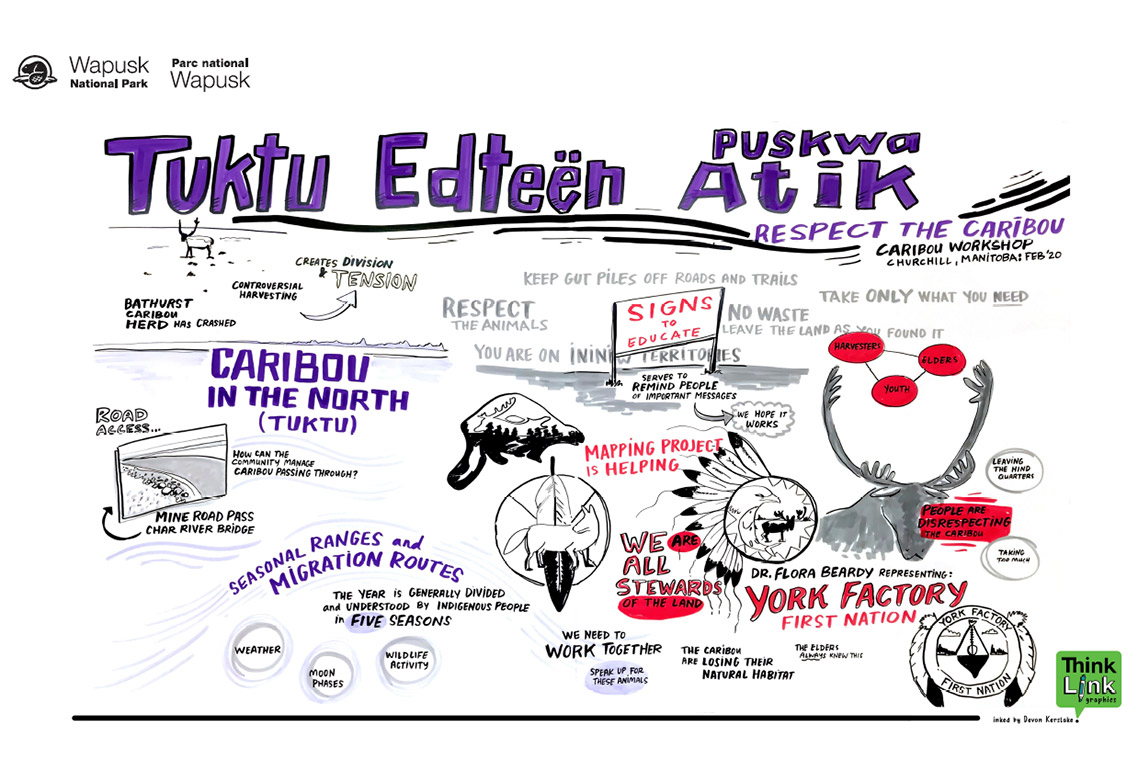
Image description
2021 infographic slides

Image description
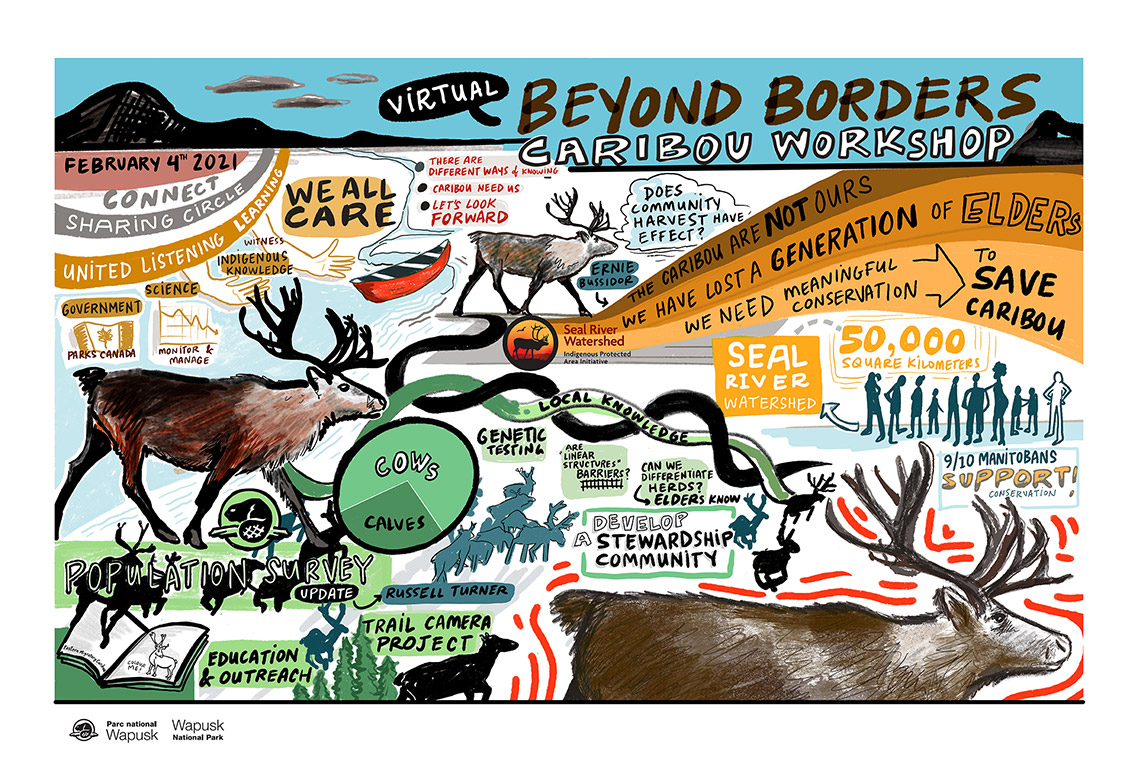
Image description
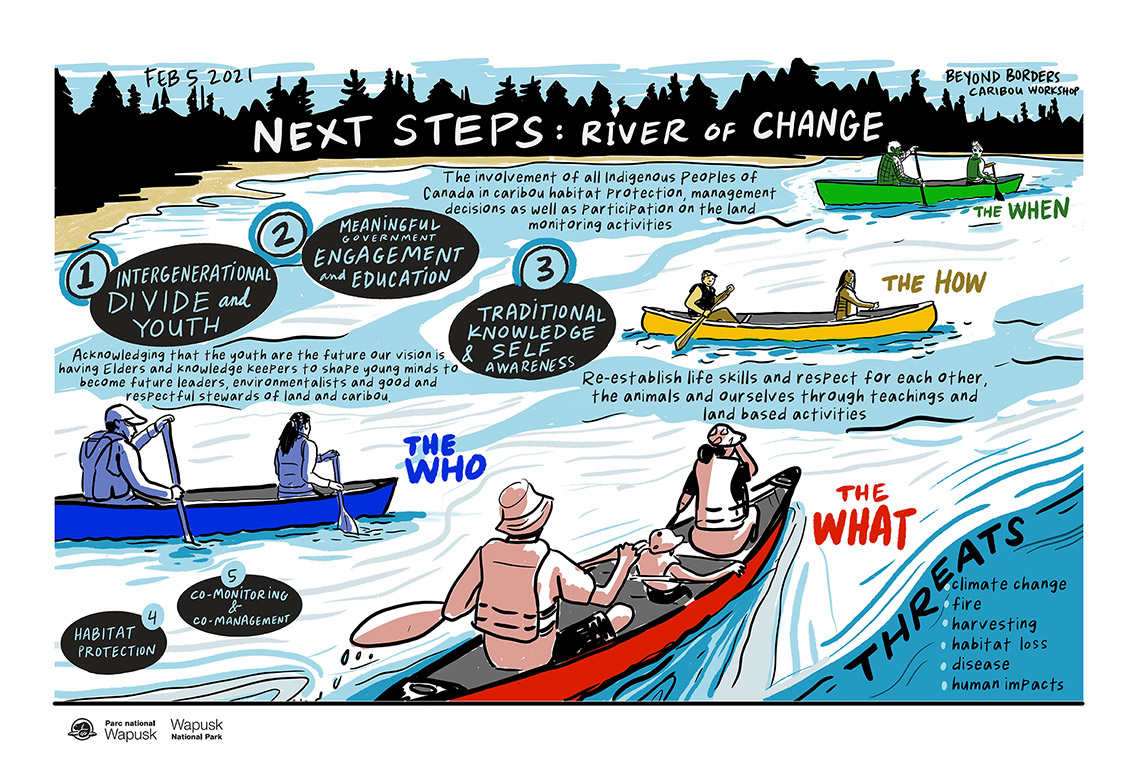
Image description
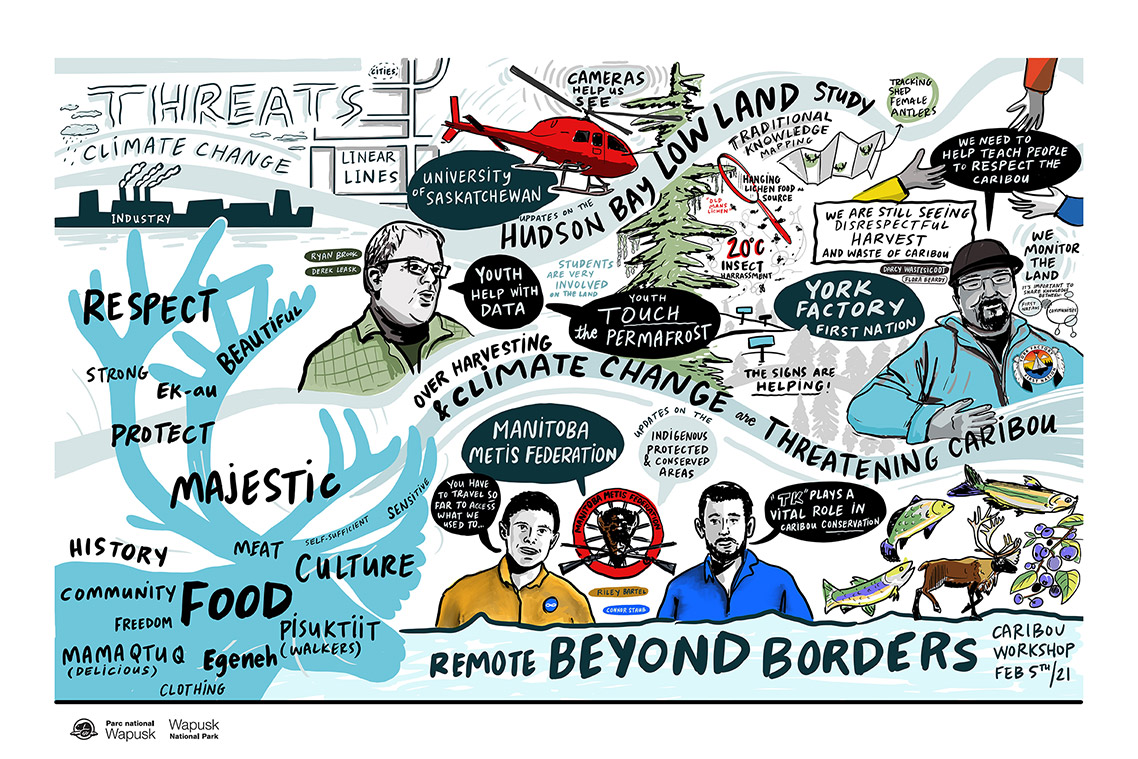
Image description
Related links
- Date modified :